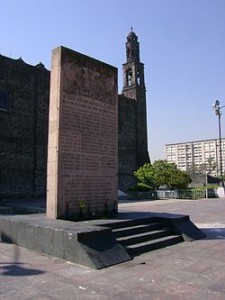Site of the Tlatelolco Massacre, Mexico City, 1968.
I am fortunate enough to be spending July in Mexico. Despite all the scary things you read online, the cancellation of study abroad programs to the country, etc., Mexico is a pleasant and safe place to be if you are not part of the drug trade. There are regions that are more safe than others, but by and large, there are no real problems for visitors, and I don’t just mean in the areas that are basically the United States like Cancun.
One of the most fascinating places in the country is the Tlatelolco plaza in Mexico City. Tlatelolco was the site of a tributary to the Mexica (or Aztec) empire based in Tenochtitlan, which was only about 2 miles away but separated by the waters of Lake Texcoco (before the lake was drained by development). It played a key role in the Spanish conquest of Mexico, for in 1521, the last Mexica emperor, Cuauhtémoc, was captured near there attempting to flee Hernán Cortés, who eventually tortured him to death. The Spanish then built a large church on the site using the stones from the Tlatelolco temples.
Much later, the Tlatelolco area became the site of urban planning experiments by the PRI, which was the party that took power in Mexico after the Mexican Revolution of the 1910s. To reward government workers and other members of the growing Mexican middle class, in the 1950s and early 1960s, the PRI built large apartment complexes around Tlatelolco. Seen as the dream of modernism come true, these apartments became a source of great pride for the Mexican middle class.
Unfortunately, by the 1950s, the PRI had become a shell of its revolutionary background. Effectively, Mexico was dominated by a 1-party state that increasingly stood for nothing except its own power. In 1958, it brutally crushed a railroad strike in a method that would have made the most right-wing dictatorship proud. It claimed the nation’s revolutionary legacy but became a political party unwilling to tolerate any dissent, marked by electoral corruption and an unwillingness to open politics to a new generation.
We in Rhode Island have a small sense of what it’s like to live under a 1-party state. The Democratic Party is so dominant in Rhode Island politics that anyone with aspirations to power becomes a Democrat, even if they don’t actually believe in the party’s principles. That’s how we get embarrassing bills like anti-choice license plates. That’s how a legislature with a 6:1 Democratic majority passes a racist voter ID bill. That’s how a party theoretically dedicated to reducing the gap between the rich and poor decimates worker pensions and attacks public sector unions. That’s how someone like Gina Raimondo, Wall Street hack, has an excellent chance of becoming the next governor of the state. What does it even mean to be a Democrat in Rhode Island? We have outstanding senators and some really great people in the state legislature, but then we also have some people who betray the very nature of the Democratic Party for their own political advancement.
1968 was a year of revolutionary foment around the world–in Paris, Prague, Tokyo, Rio de Janeiro, college campuses across the United States, not to mention the anti-imperialist and anti-colonial struggles happening across Asia and Africa. Mexico City also saw huge protests. Students marched during that summer and early fall to demand the dismantling of the secret police force and to open up civil society to the general populace. But that fall Mexico City hosted the Olympics and the PRI wanted no protests against its signature event. Mexican President Gustavo Díaz Ordaz and his Minister of the Interior and successor as president, Luis Echeverría, decided to crack down. On October 2, 1968, ten days before the Olympics began, students marched at the Tlatelolco Plaza. PRI agents kicked people out of their apartments in the housing surrounding the plaza, set snipers in the windows, and opened fire. When this happened, the military watching the protest below also fired into the crowd. Likely, the military did not know about the snipers and thought the protestors had fired upon them.
Protestors arrested after massacre
To this day, no one knows how many people died. The government originally claimed it was 4. Some have said up to 1000 or even more. There are about 40 clearly documented deaths. Thousands were arrested, beaten, and tortured. Some were disappeared in Mexican prisons, never to be heard from again. The Tlatelolco Massacre ended any legitimacy the PRI had for its revolutionary background.
Monument to the dead
It took Mexico a long time to deal with the massacre. But the nation has increasingly come to a reckoning with the past. The PRI lost power for 12 years until winning it back in the 2012 elections. More directly, the government has opened a powerful new museum about the massacre at the site. Filled with documents, artifacts, and interviews of the survivors projected in video screens throughout the exhibit, it would stand as an excellent museum regardless of the subject matter. That it so powerfully displays for everyone the real causes of the massacre and its horrible aftermath makes arguably the most important space for discussing modern Mexican history.





